Validation through Experiment and Simulation of Internal Charging–Discharging Characteristics of Polyimide under High-Energy Electron Radiation
Abstract
:1. Introduction
2. Experiment and Simulation Methods of Internal Charging–Discharging under High-Energy Electron Radiation
2.1. Measurement System of Charge Distribution under High-Energy Electron
2.1.1. Design of Electrode System
2.1.2. Waveform Recovery of Space Charge Distribution
2.2. Measurement System of Electrostatic Discharging under High-Energy Electron Radiation
2.3. Joint Simulation Method of Internal Charging Characteristics under High-Energy Electron Radiation
2.3.1. Electron Injection Process
2.3.2. The 3D Charge Transportation Model
2.3.3. Joint Simulation Method under High-Energy Electron Radiation
3. Evaluation Results of Internal Charging under High-Energy Electron Radiation
3.1. Internal Charging at Different Electron Energies
3.1.1. Space Charge Distribution Based on In-Situ PEA Method
3.1.2. Deposition Charge Distribution Based on Joint Simulation Method
3.1.3. Comparative Analysis of Charging Characteristics under High-Energy Electron Radiation
- In the theoretical calculation, the peak value under the three groups of energies is similar. First, there is a certain deviation in the theoretical empirical equation; in particular, the parameters in Equation (13) have a great influence on the results. On the other hand, in the theoretical calculation, the grounding of the sample on both sides, together with the release of the deposited charge, are not considered. However, theoretical calculation still has a certain reference for the depth of charge deposition.
- In the simulation method, the charge transportation to the ground through bulk conduction is considered with constant charge injection. Therefore, the overall charge amount in the sample will be equal under the same radiation time, and thus the area enclosed by the horizontal axis and charge density curve are almost the same under three energies in the simulation calculation. However, the measurement results of the total charge amount among the three energies show an obvious difference, which may be due to the more intense charge release process caused by the higher electric field near the grounded electrode.
3.2. Internal Charging under Different Radiation Time
4. Evaluation of Internal Discharging under High-Energy Electron Radiation
4.1. Experiment Result of Discharging Evaluation
4.2. Simulation Results of Discharging and Comparative Analysis
- Single electrostatic discharging. According to Section 4.1, the average electrostatic discharge quantity QESD per unit time of PI is 1.0 × 10−6 C. In the experiment, there may be multiple discharges, but the discharge waveform collected by the oscilloscope is regarded as a single discharging;
- Electron backscattering. Under high-energy electric radiation, the backscattered electron yield of PI is generally about 0.1~0.2, so the Qbackscatter by the surface per unit time should not exceed 10% of the total amount of injected charges;
- Intrinsic conductance. Since the intrinsic conductivity of PI is extremely low, the amount of charge released by the intrinsic conductivity is almost negligible;
- High temperature and high-field conductance. Due to the increase in the electric field inside the PI and the influence of the radiant heat, electrostatic discharging effect and the difficulty of heat dissipation in the vacuum environment, the PI may be in a relatively high conductivity during the radiation process. According to Yi’s research [32], considering a condition of 10 kV/mm and 353 K under radiation, the bulk conductivity may conform to the following laws.where k is the Boltzmann constant, T is the absolute temperature, K; EA is the activation energy of conductivity, A is the coefficient related to the dielectric conductivity at room temperature, E is the electric field strength, V/m; e is the electron charge; βF = (e3/πε)0.5 depends on the permittivity; δ is the jump distance of electrons, generally 1 nm. According to Equations (16) and (17), it is roughly obtained that the bulk conductivity of the PI during the discharge process is about 7.5 × 10−13 S/m;
- Radiation-induced conductance. Although the release of the deposited charge in the zone near the back electrode is less affected by high-energy electron radiation, the overall charge transportation in the radiation zone is accelerated, leading to an enhanced charge release. According to Equations (9)–(11), the σRIC tends to rise by 2–3 orders of magnitude relative to the intrinsic conductivity.
5. Conclusions
Author Contributions
Funding
Data Availability Statement
Conflicts of Interest
References
- Lai, S.T. Fundamentals of Spacecraft Charging: Spacecraft Interactions with Space Plasmas; Princeton University Press: Oxford, UK, 2012; pp. 205–229. [Google Scholar]
- Ji, X.; Li, Y.; Liu, G.; Wang, J.; Xiang, S.; Yang, X.; Bi, Y. A brief review of ground and flight failures of Chinese spacecraft. Prog. Aerosp. Sci. 2019, 107, 19–29. [Google Scholar] [CrossRef]
- Frederickson, A.R.; Dennison, J.R. Measurement of conductivity and charge storage in insulators related to spacecraft charging. IEEE Trans. Nucl. Sci. 2003, 50, 2284–2291. [Google Scholar] [CrossRef]
- Green, N.W.; Dennison, J.R. Deep dielectric charging of spacecraft polymers by energetic protons. IEEE Trans. Plasma Sci. 2008, 36, 2482–2490. [Google Scholar] [CrossRef]
- Fukuma, M.; Maeno, T.; Fukunaga, K.; Nagao, M. High repetition rate PEA system for in-situ space charge measurement during breakdown tests. IEEE Trans. Dielectr. Electr. Insul. 2004, 11, 155–159. [Google Scholar] [CrossRef]
- Wang, V.; Wu, J.; Yin, Y. Nanostructures and space charge characteristics of MgO/LDPE nanocomposites. IEEE Trans. Dielectr. Electr. Insul. 2017, 24, 2390–2399. [Google Scholar] [CrossRef]
- Rizzo, G.; Romano, P.; Imburgia, A.; Ala, G. Review of the PEA method for space charge measurements on HVDC cables and mini-cables. Energies 2019, 12, 3512. [Google Scholar] [CrossRef]
- Enoki, K.; Endo, K.; Miyake, H.; Tanaka, Y. Surface and internal charge measurement in fluorinated polymer irradiated by electron using non-contact type PEA method. IEEJ Trans. Fundam. Mater. 2021, 141, 665–671. [Google Scholar] [CrossRef]
- Laurent, C.; Teyssedre, G.; Le Roy, S.; Baudoin, F. Charge dynamics and its energetic features in polymeric materials. IEEE Trans. Dielectr. Electr. Insul. 2013, 20, 357–381. [Google Scholar] [CrossRef]
- Griseri, V.; Fukunaga, K.; Maeno, T.; Laurent, C.; Levy, L.; Payan, D. Pulsed electro-acoustic technique applied to in-situ measurement of charge distribution in electron-irradiated polymers. IEEE Trans. Dielectr. Electr. Insul. 2004, 11, 891–898. [Google Scholar] [CrossRef]
- Perrin, C.; Griseri, V.; Inguimbert, C.; Laurent, C. Analysis of internal charge distribution in electron irradiated polyethylene and polyimide films using a new experimental method. J. Phys. D 2008, 41, 205417. [Google Scholar] [CrossRef]
- Arnaout, M.; Paulmier, T.; Dirassen, B.; Payan, D. Non-contact in-situ pulsed electro acoustic method for the analysis of charge transport in irradiated space-used polymers. J. Electrost. 2015, 77, 123–129. [Google Scholar] [CrossRef]
- NASA-HDBK-4002A; Mitigating in Space Charging Effects—A Guideline. NASA: Washington, DC, USA, 2011; p. 33.
- Sorensen, J.; Rodgers, D.J.; Ryden, K.A.; Latham, P.M.; Wrenn, G.L.; Levy, L.; Panabiere, G. ESA’s tools for internal charging. IEEE Trans. Nucl. Sci. 2000, 47, 491–497. [Google Scholar] [CrossRef]
- Mateo-Velez, J.C.; Theillaumas, B.; Sevoz, M.; Andersson, B.; Nilsson, T.; Sarrailh, P.; Thiebault, B.; Jeanty-Ruard, B.; Rodgers, D.; Balcon, N. Simulation and analysis of spacecraft charging using SPIS and NASCAP/GEO. IEEE Trans. Plasma Sci. 2015, 43, 2808–2816. [Google Scholar] [CrossRef]
- Wang, S.; Tang, X.; Wu, Z.; Yi, Z. Internal dielectric charging simulation of a complex structure with different shielding thicknesses. IEEE Trans. Plasma Sci. 2015, 43, 4169–4174. [Google Scholar] [CrossRef]
- Sarrailh, P.; Paulmier, T.; Dirassen, B.; Rodgers, D.; Santin, G.; Cipriani, F.; Payan, D. Validation through experiments of a 3-D time-dependent model of internal charging. IEEE Trans. Plasma Sci. 2017, 45, 2566–2572. [Google Scholar] [CrossRef]
- Jun, I.; Garrett, H.B.; Kim, W.; Minow, J.I. Review of an internal charging code, NUMIT. IEEE Trans. Plasma Sci. 2008, 36, 2467–2472. [Google Scholar]
- Kim, W.; Chinn, J.Z.; Katz, I.; Garrett, H.B.; Wong, K.F. 3-D NUMIT: A general 3-D internal charging code. IEEE Trans. Plasma Sci. 2017, 45, 2298–2302. [Google Scholar] [CrossRef]
- Zuo, Y.; Wang, J.; Niu, S.; Wei, Y. Simulations of internal charging effects of artificial radiation belt on dielectric material. IEEE Trans. Nucl. Sci. 2021, 68, 1120–1128. [Google Scholar] [CrossRef]
- Tang, X.; Yi, Z.; Meng, L.; Liu, Y.; Zhang, C.; Huang, J.; Wang, Z. 3-D internal charging simulation on typical printed circuit board. IEEE Trans. Plasma Sci. 2013, 41, 3448–3452. [Google Scholar] [CrossRef]
- Li, G.; Li, S.; Min, D.; Zheng, X.; Yang, S.; Tang, D.; Shi, L.; Zhao, C. Deep dielectric charging characteristics of ring structure irradiated by energetic electrons. IEEE Trans. Dielectr. Electr. Insul. 2015, 22, 2349–2357. [Google Scholar] [CrossRef]
- Wang, J.; Liu, R.; Xiao, R.; Ping, A.; Liu, J.; Zhang, M.; Li, Q. Optimized design of slip ring assembly for aerospace to reduce deep dielectric charging. IEEE Trans. Nucl. Sci. 2022, 69, 915–924. [Google Scholar] [CrossRef]
- Wang, X.; Min, D.; Pan, S.; Zheng, S.; Hou, X.; Wang, L.; Li, S. Coupling effect of electron irradiation and operating voltage on the deep dielectric charging characteristics of solar array drive assembly. IEEE Trans. Nucl. Sci. 2021, 68, 1399–1406. [Google Scholar] [CrossRef]
- Fukuma, M.; Funo, R.; Murakami, Y.; Nagao, M.; Hozumi, N. Measurement of acoustic property for signal recovery in PEA method. In Proceedings of the 2011 International Symposium on Electrical Insulating Materials, Kyoto, Japan, 7–11 September 2011; pp. 69–72. [Google Scholar]
- Hole, S. Behind space charge distribution measurements. IEEE Trans. Dielectr. Electr. Insul. 2012, 19, 1208–1214. [Google Scholar] [CrossRef]
- Murkami, Y.; Sugiyama, T.; Kasashima, T.; Nagao, M.; Fukuma, M. Signal recovery of space charge distribution using acoustic property in PEA method. In Proceedings of the IEEE International Conference on the Properties and Applications of Dielectric Materials, Sydney, NSW, Australia, 19–22 July 2015; pp. 1208–1214. [Google Scholar]
- Qin, X.; He, D.; Wang, J. Geant4-based calculation of electric field in deep dielectric charging. Acta Phys. Sin. 2009, 58, 684–689. [Google Scholar]
- Yuan, Q.; Wang, S.; Huang, X. 3-D simulation of internal dielectric charging characteristics of spacecraft dielectric disc structure. Acta Aeronaut. Astronaut. Sin. 2019, 40, 289–298. [Google Scholar]
- Pan, S.; Min, D.; Wang, X.; Hou, X.; Wang, L.; Li, S. Effect of electron irradiation and operating voltage on the deep dielectric charging characteristics of polyimide. IEEE Trans. Nucl. Sci. 2018, 66, 549–556. [Google Scholar] [CrossRef]
- Li, S.; Li, G.; Min, D.; Zhao, N. Influence of radiation electron energy on deep dielectric charging characteristics of low density polyethylene. Acta Phys. Sin. 2013, 62, 593–602. [Google Scholar]
- Zhong, Y.; Wang, S.; Tang, X.; Wu, Z.; Zhang, C. Computer simulation on temperature-dependent internal charging of complex dielectric structure. Acta Phys. Sin. 2015, 64, 307–315. [Google Scholar] [CrossRef]

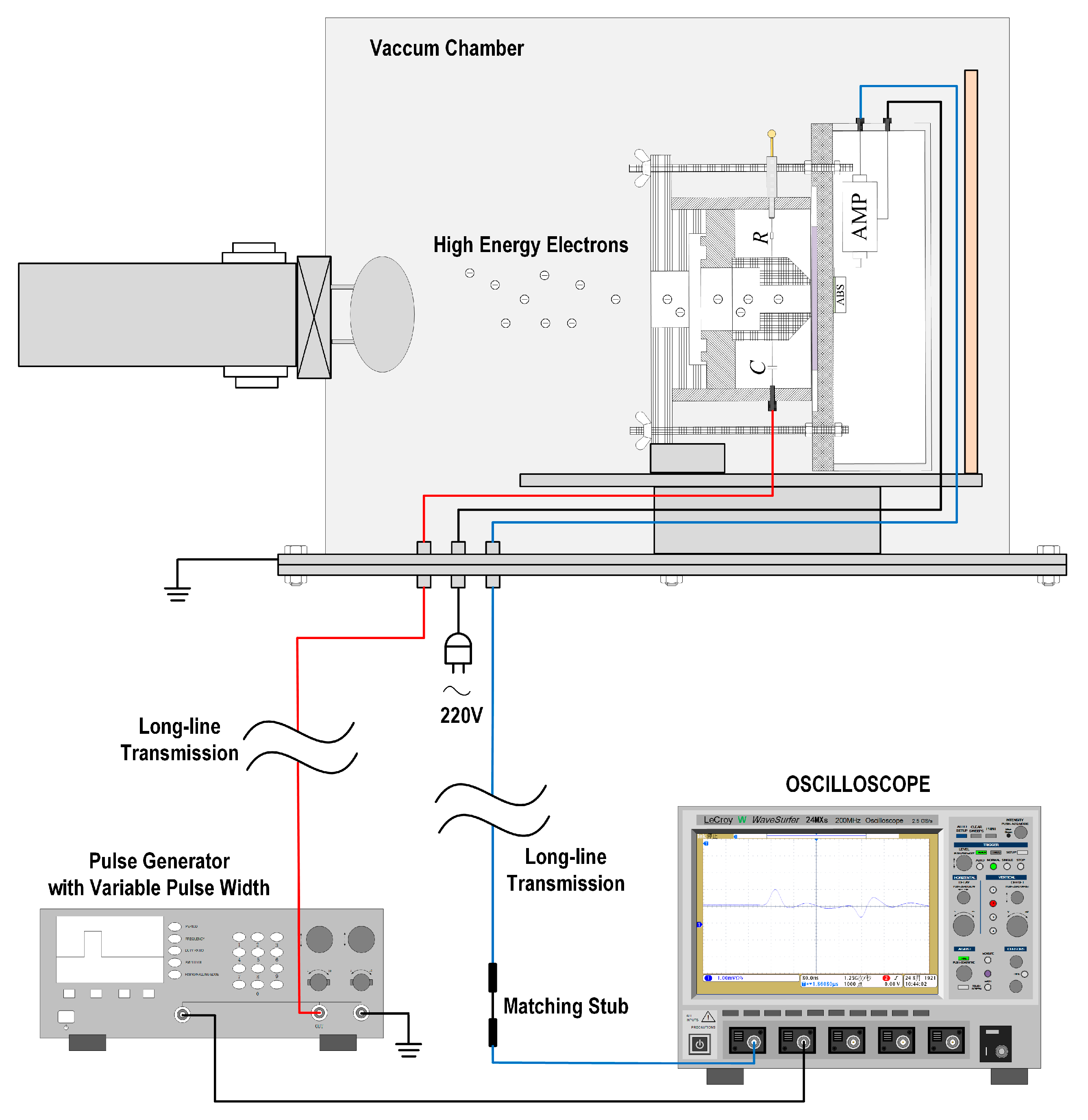
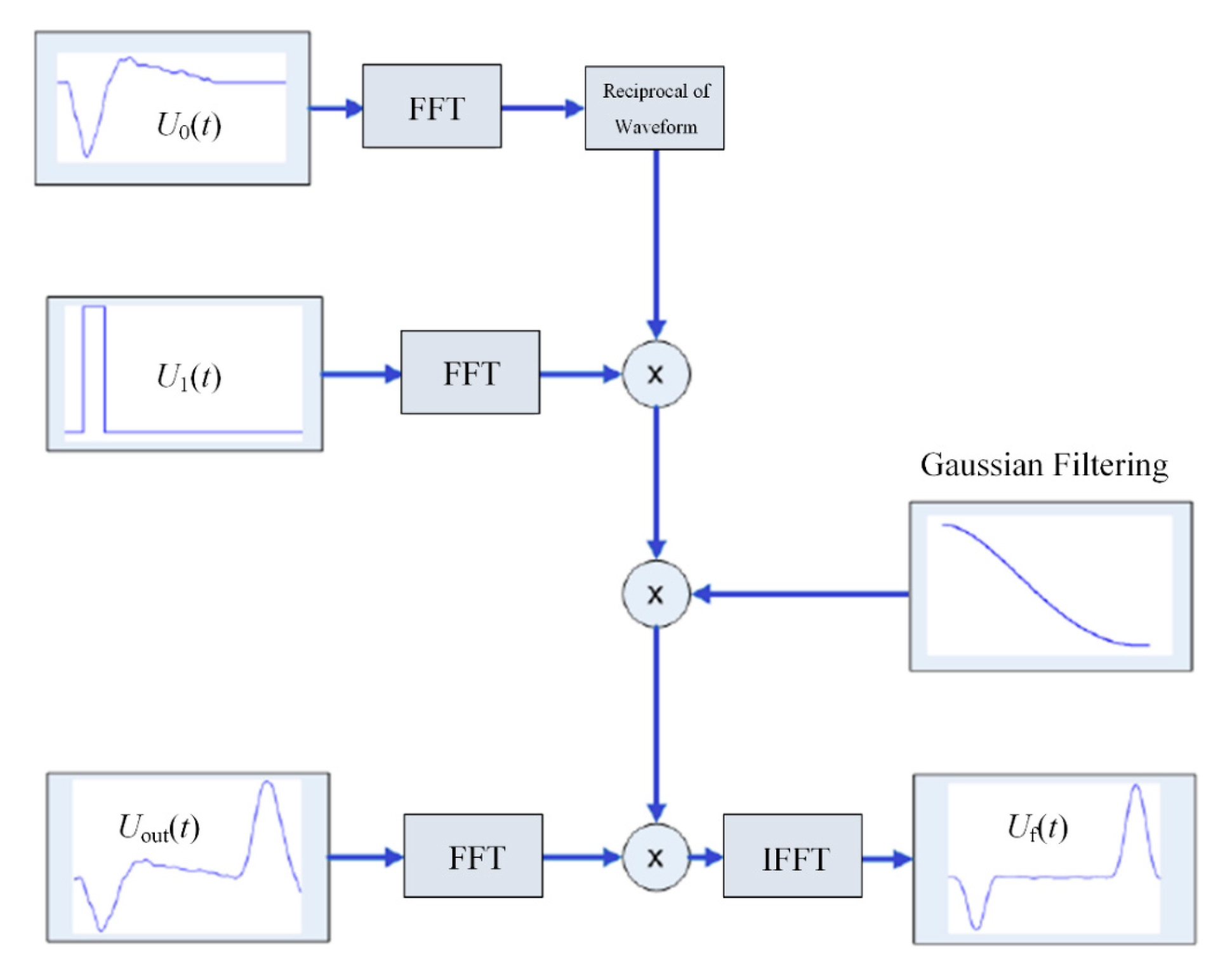
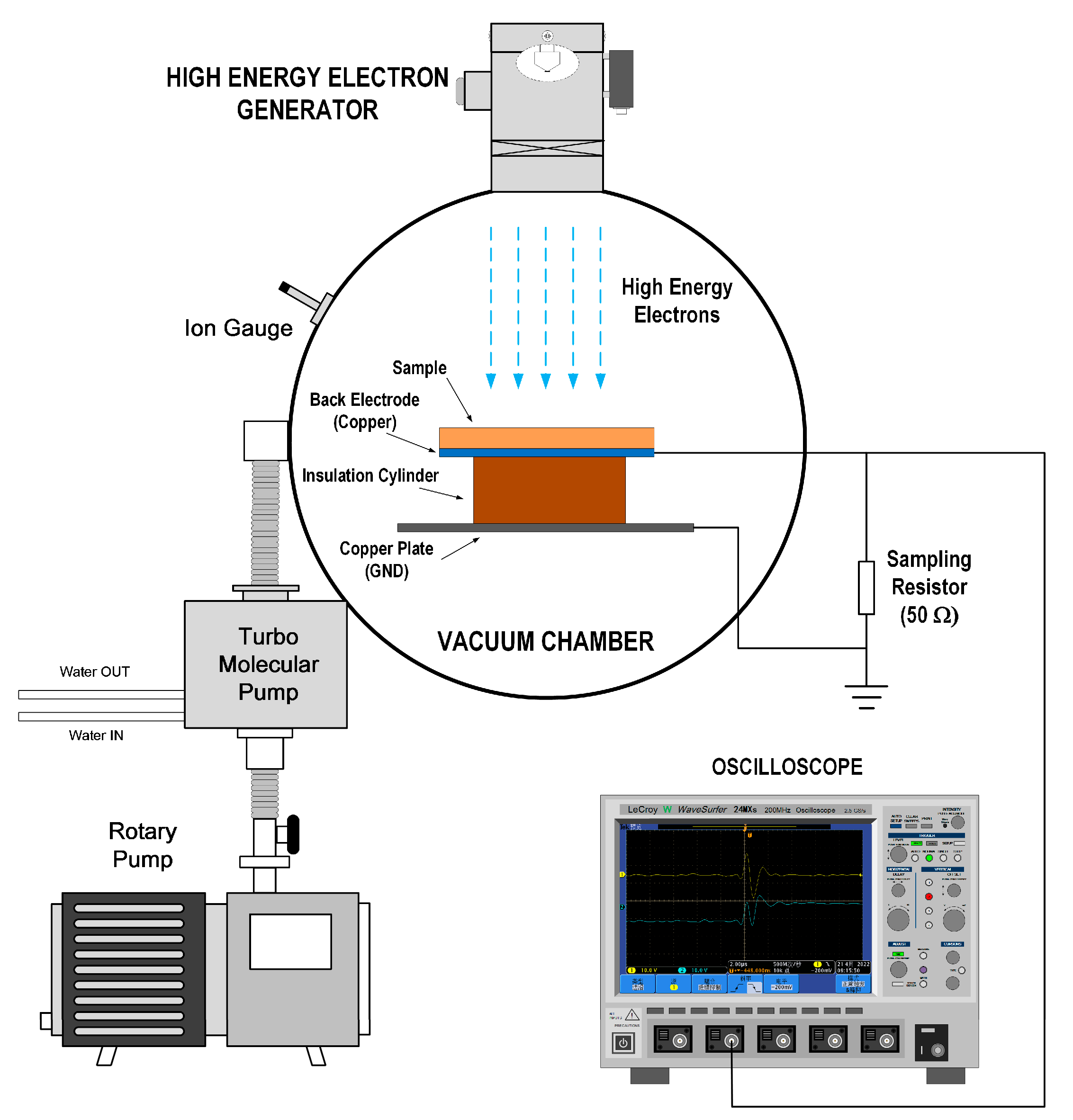
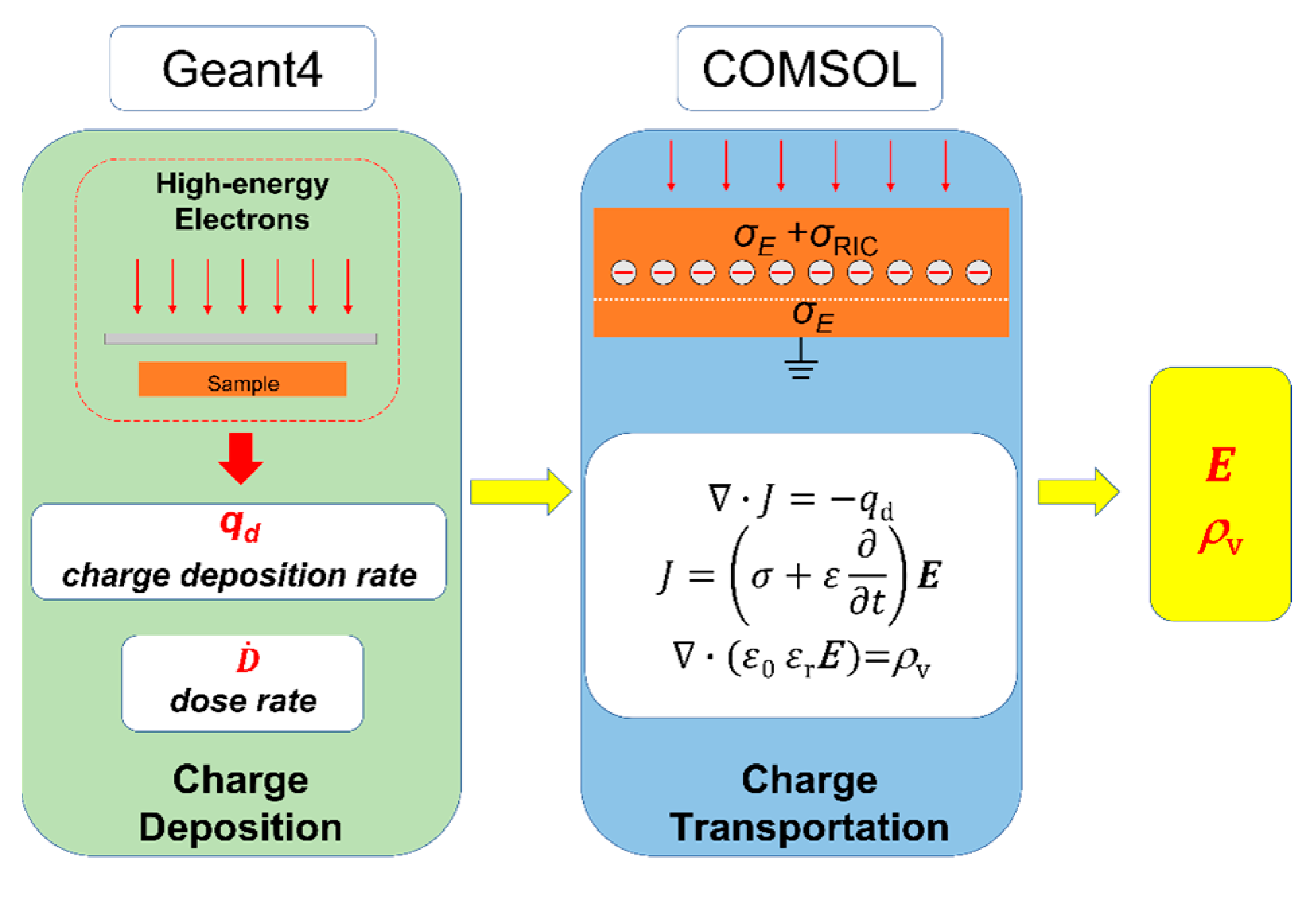
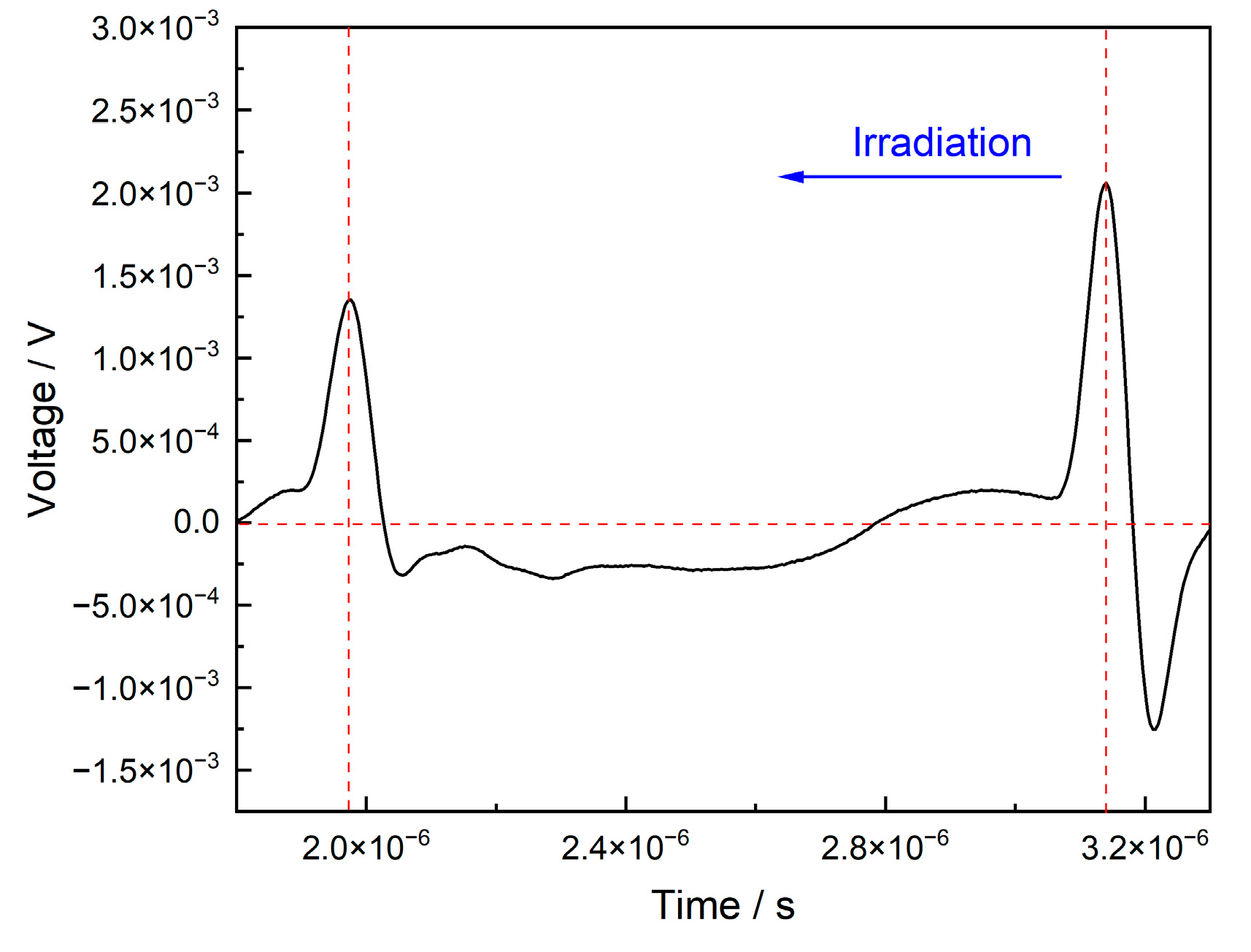

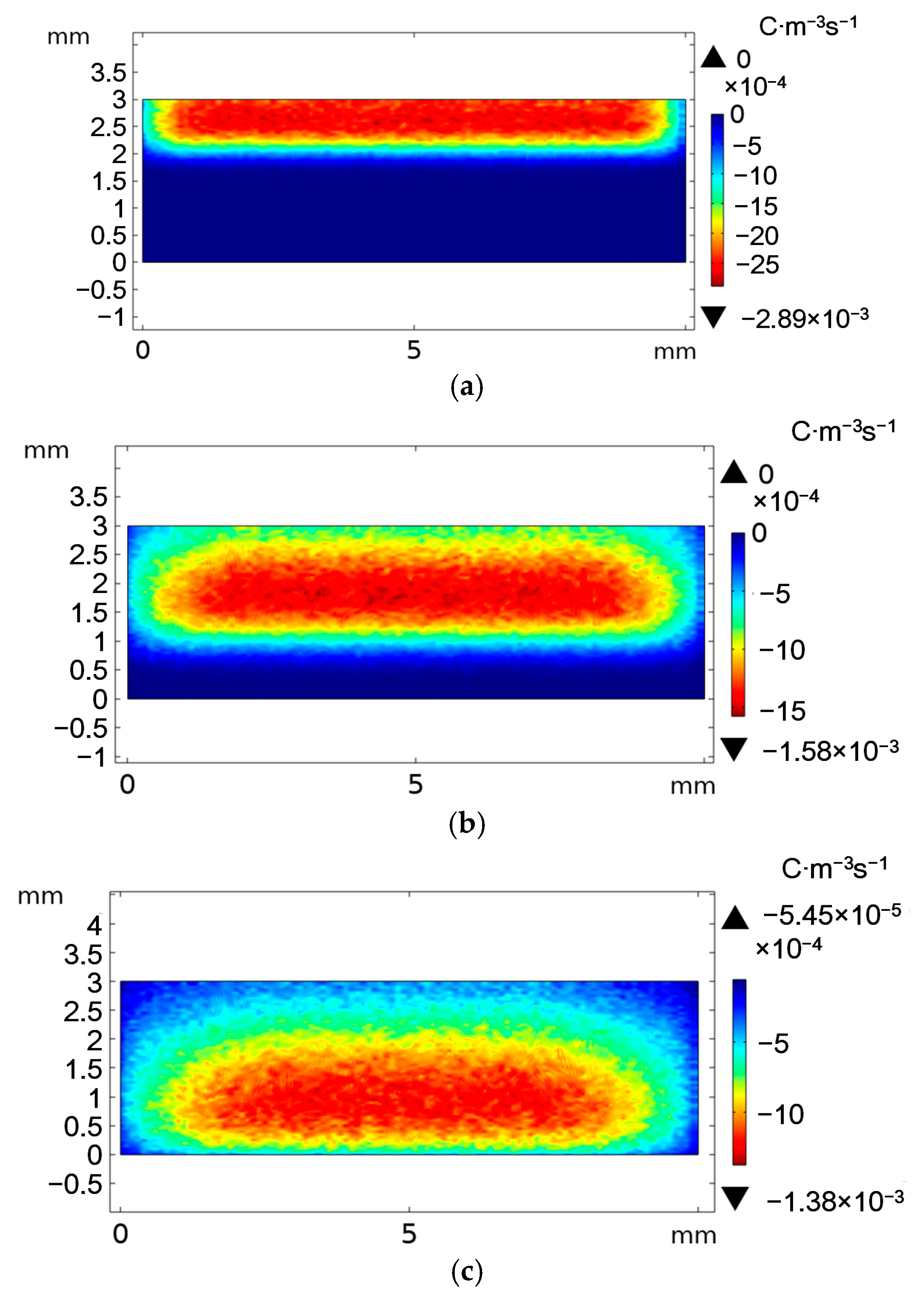
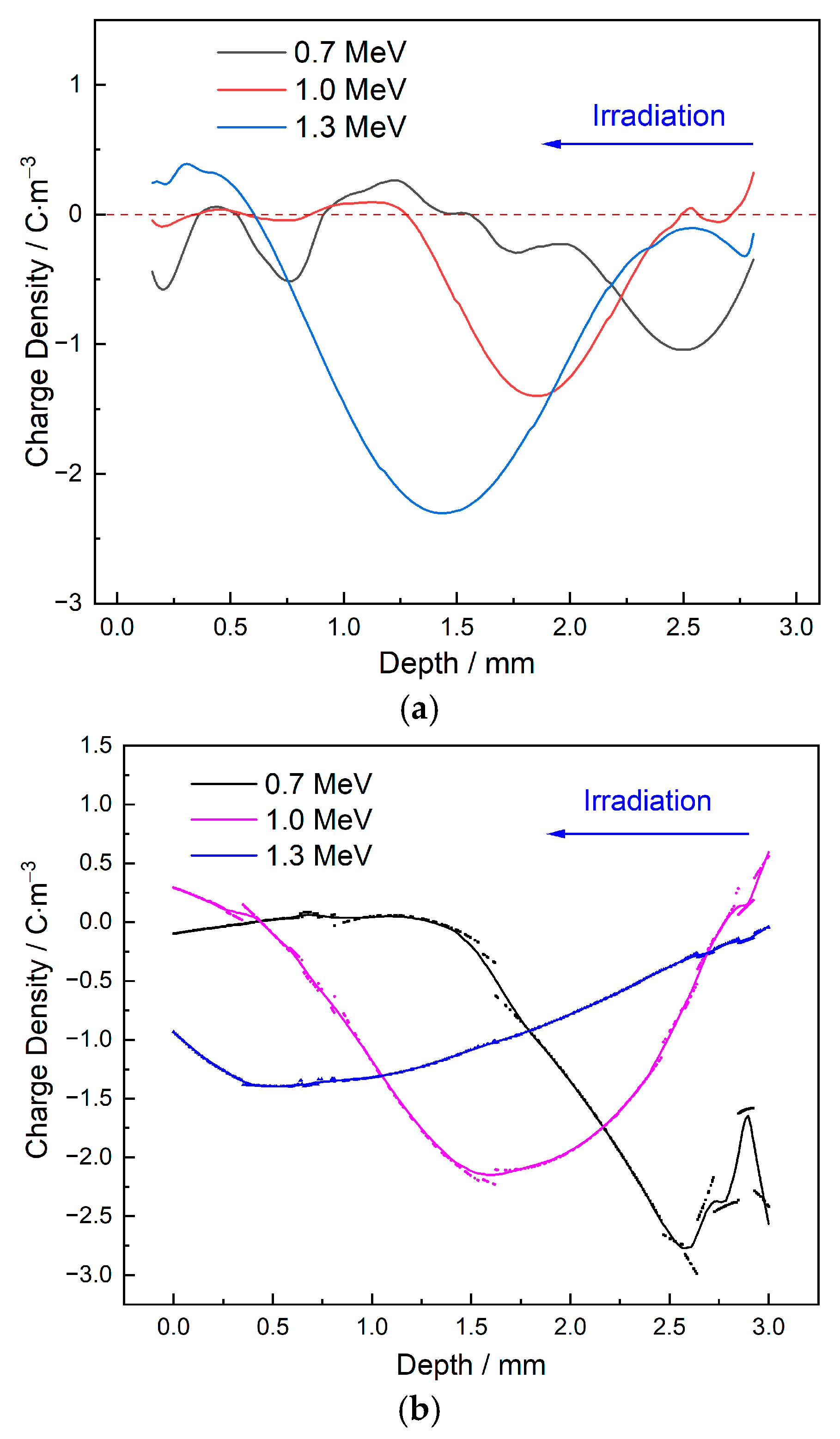
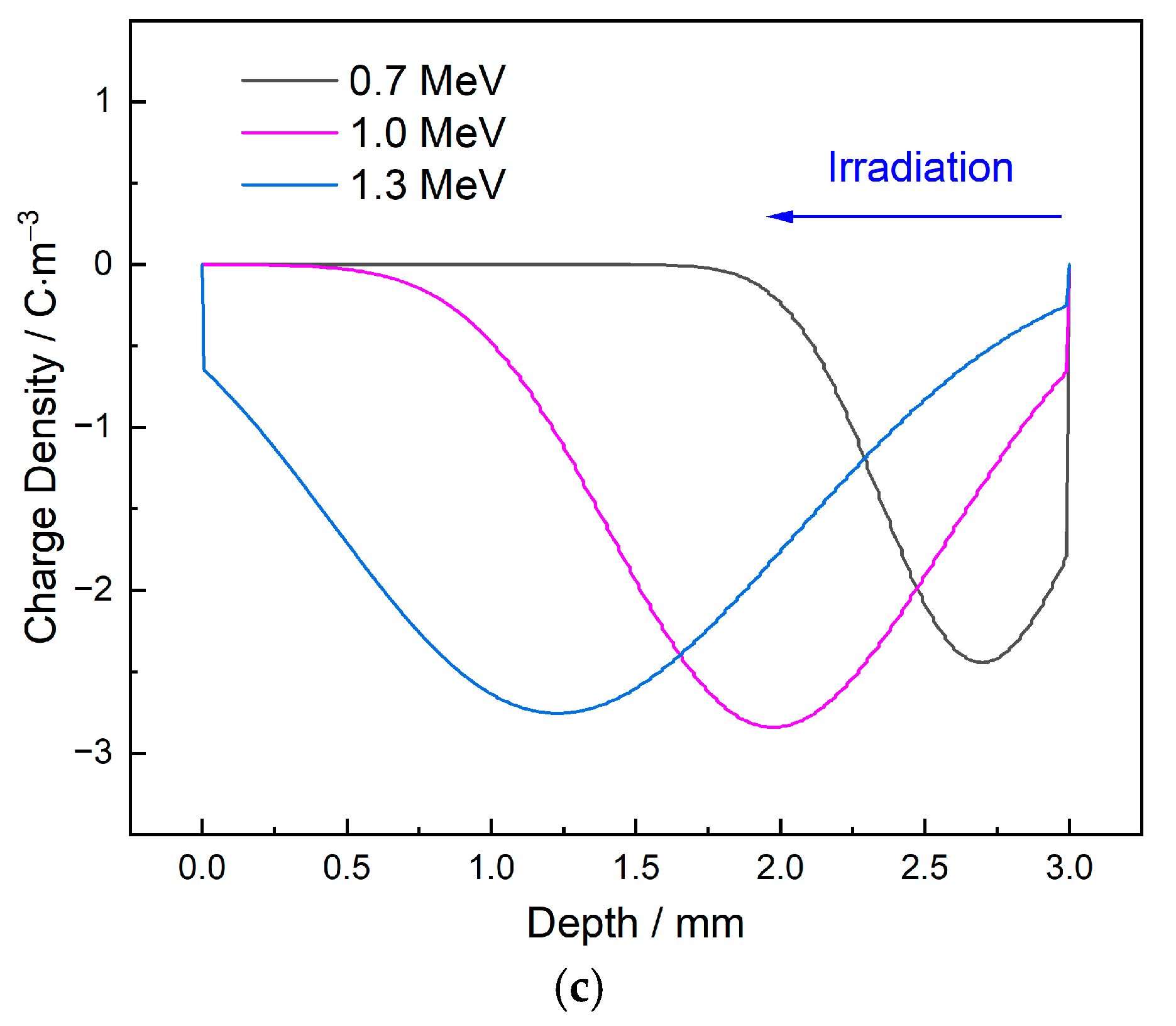
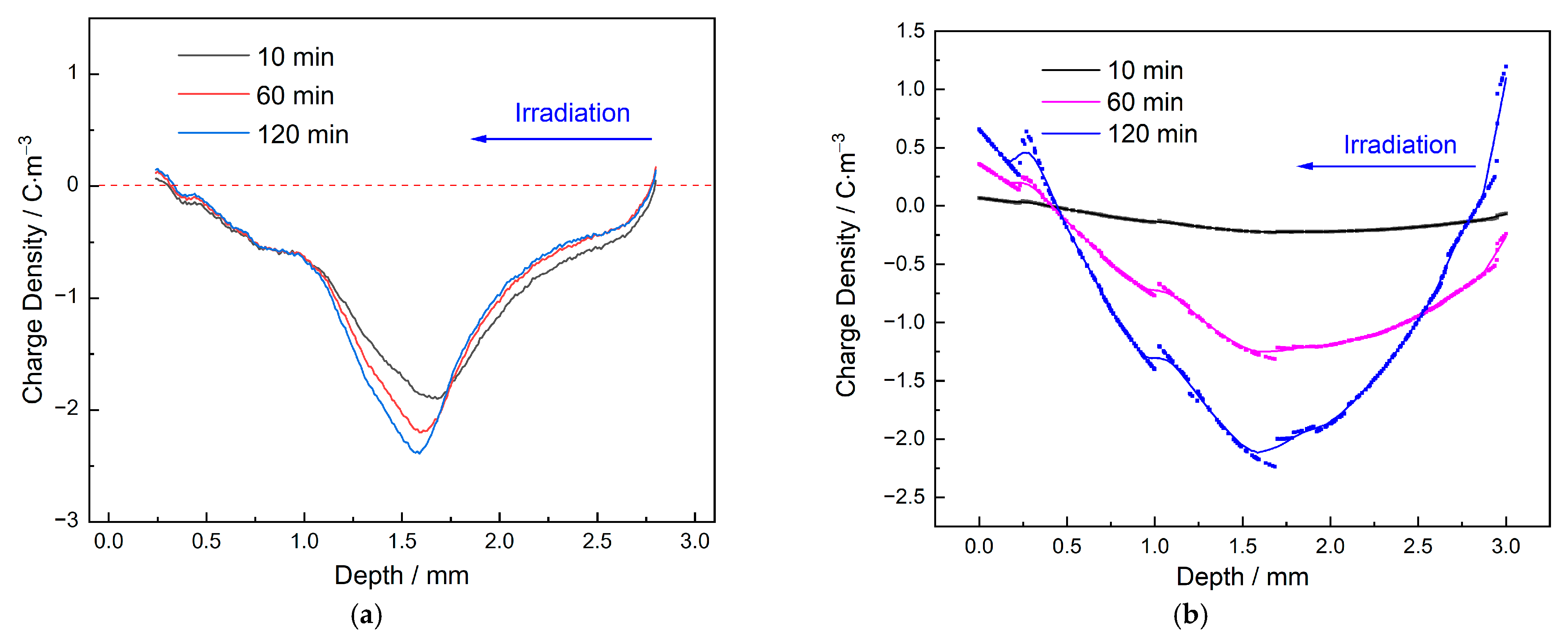
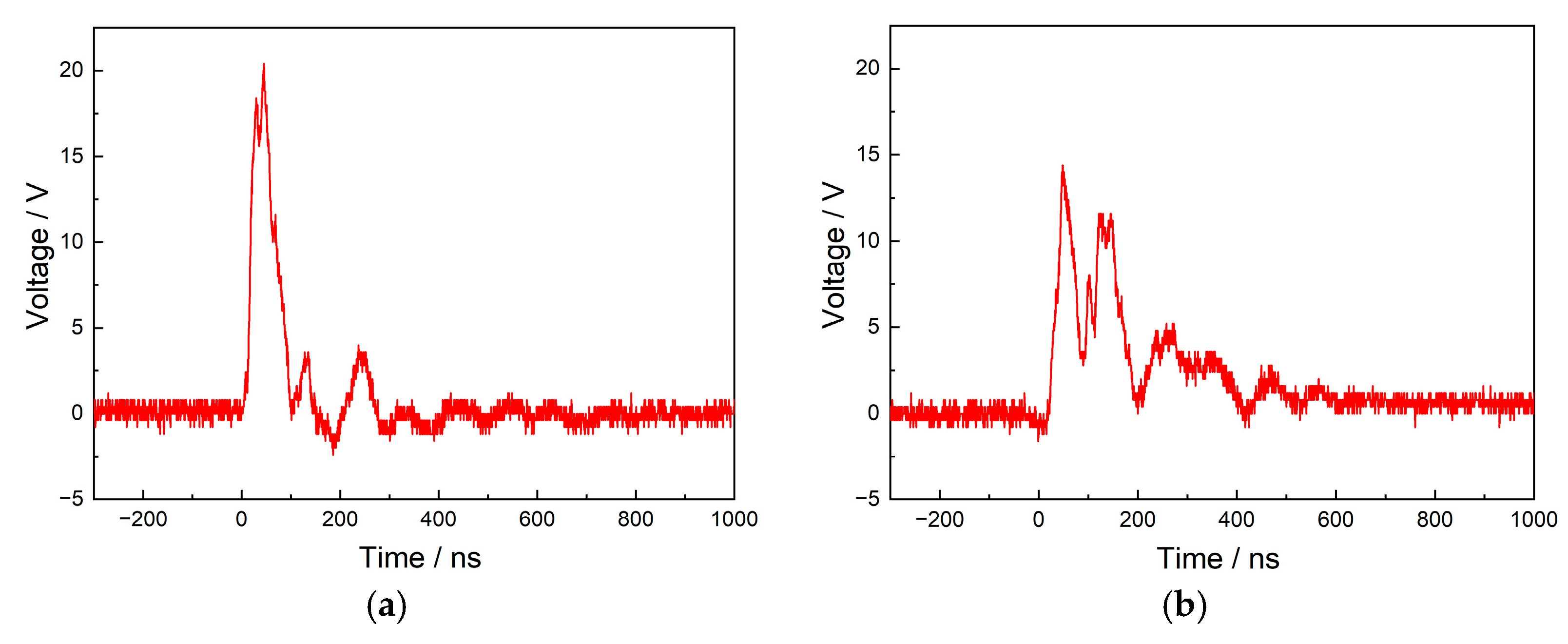
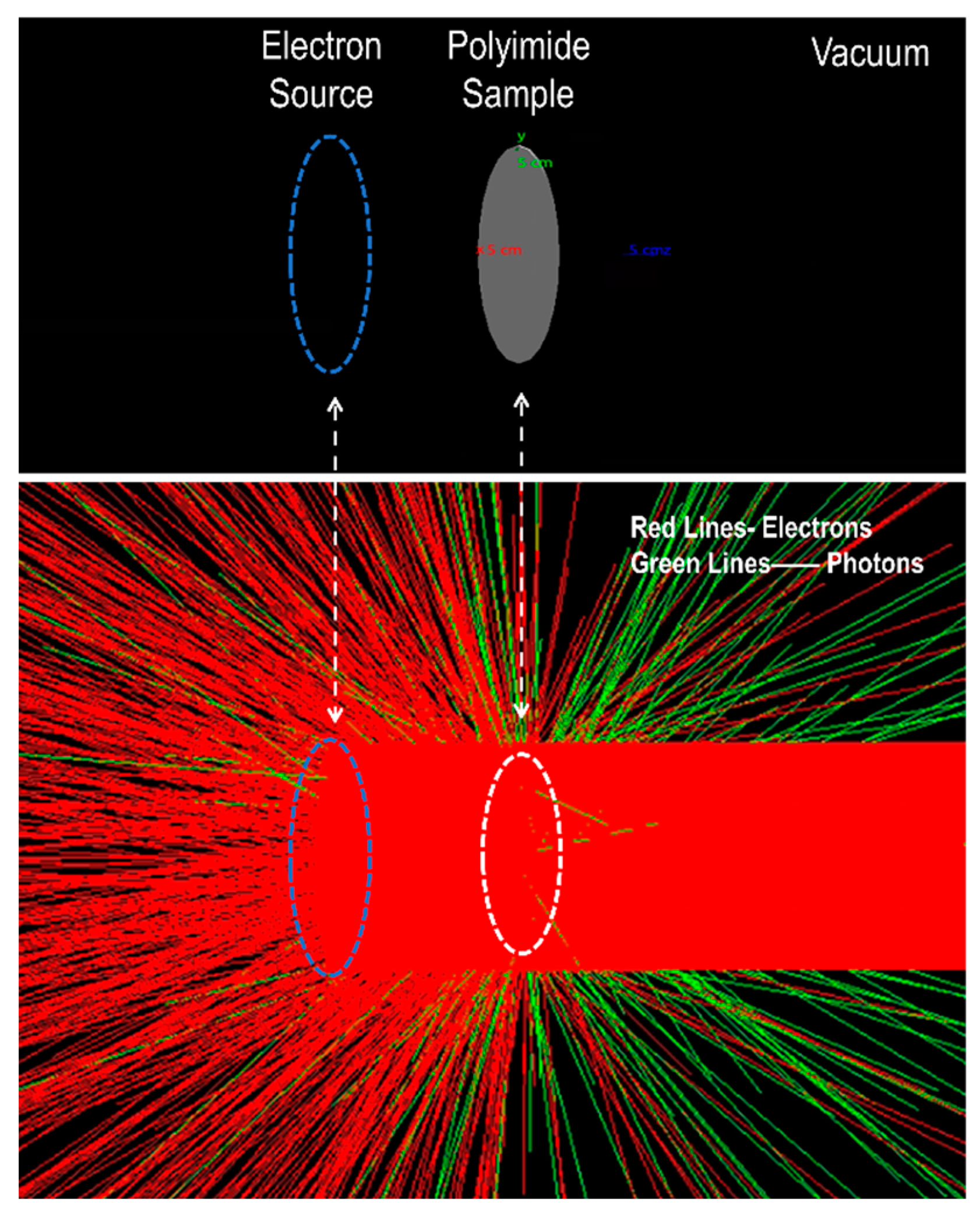
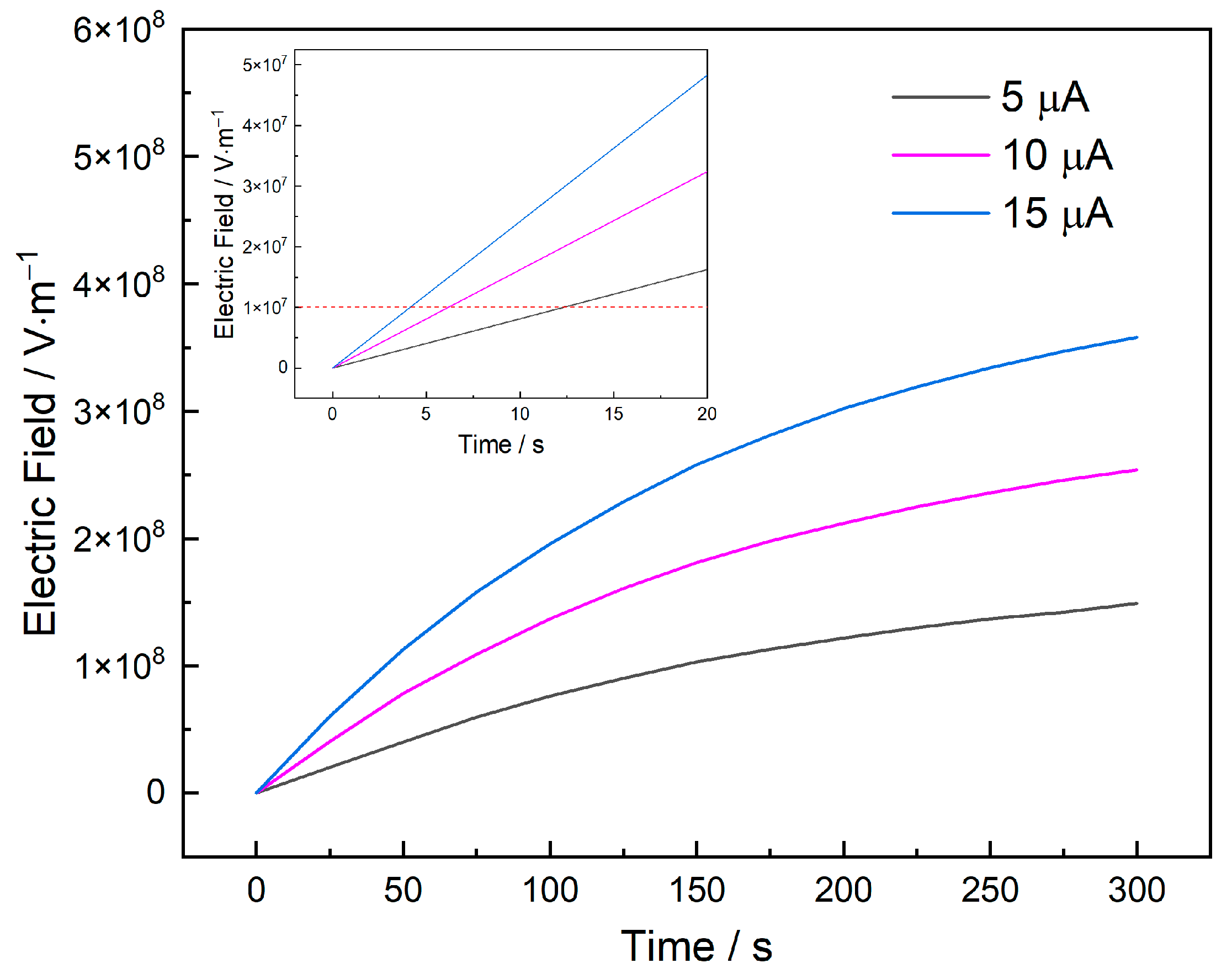
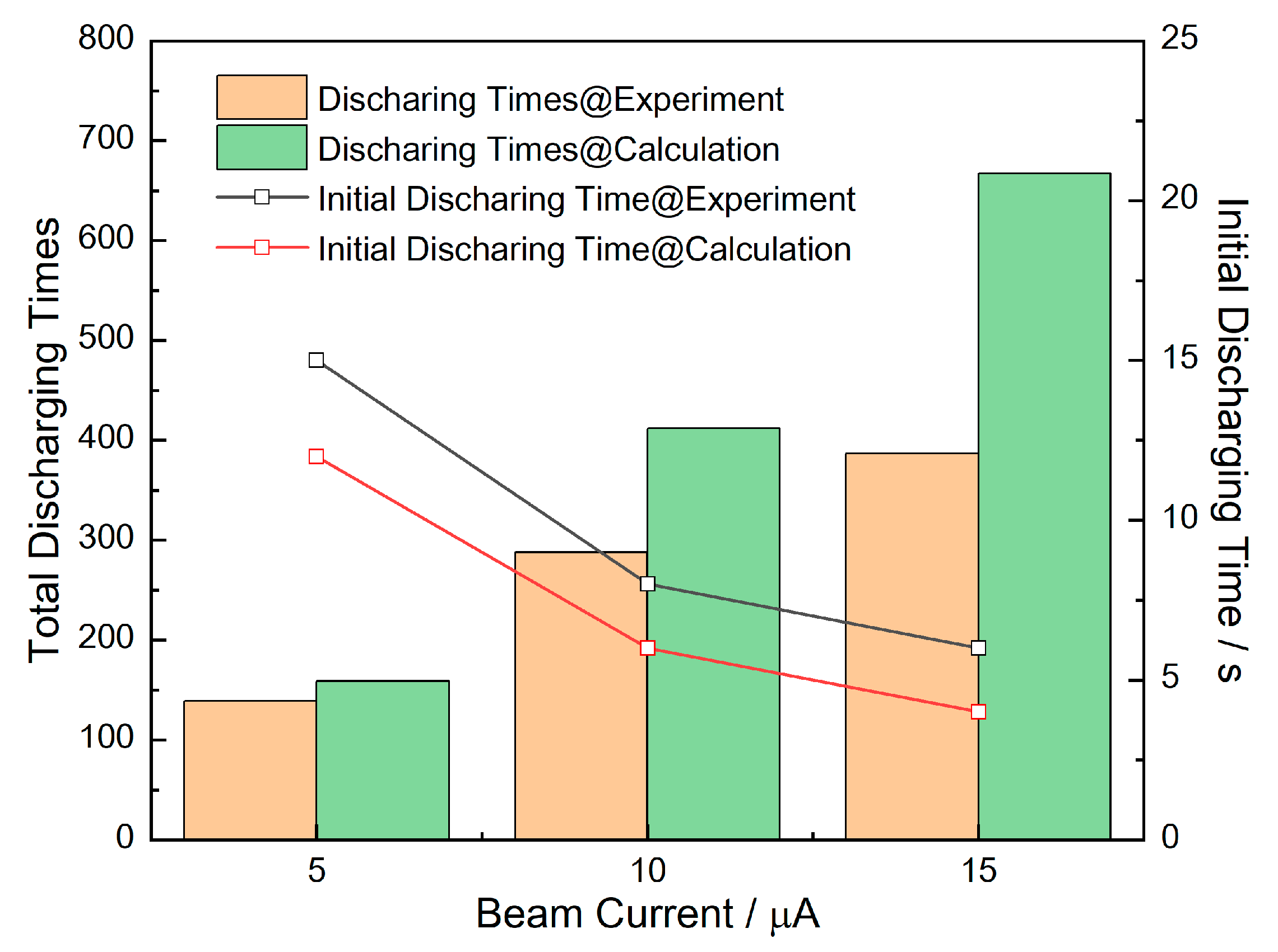
| Parameter | Value |
|---|---|
| εr | 3.45 |
| T | 293 K |
| ρ | 1417 kg/m3 |
| kRIC(T) | 3.63 × 10−15 |
| Δ(T) | 0.76 |
| σ0 | 3.6 × 10−17 S/m |
| Penetrating Depth of Peak/mm | Peak Value of Charge Density/C·m−3 | |||||
|---|---|---|---|---|---|---|
| 0.7 MeV | 1.0 MeV | 1.3 MeV | 0.7 MeV | 1.0 MeV | 1.3 MeV | |
| Experiment | 0.5 | 1.1 | 1.6 | −1.1 | −1.4 | −2.3 |
| Simulation | 0.4 | 1.4 | 2.4 | −2.7 | −2.2 | −1.4 |
| Theory | 0.3 | 1.0 | 1.8 | −2.5 | −2.8 | −2.6 |
| Penetrating Depth of Peak/mm | Peak Value of Charge Density/C·m−3 | |||||
|---|---|---|---|---|---|---|
| 10 min | 60 min | 120 min | 10 min | 60 min | 120 min | |
| Experiment | 1.3 | 1.4 | 1.4 | −1.9 | −2.2 | −2.4 |
| Simulation | 1.3 | 1.4 | 1.4 | −0.22 | −1.3 | −2.1 |
| Beam Current/μA | Total Discharging Times | Initial Discharging Time/s |
|---|---|---|
| 5 | 139 | 15 |
| 10 | 288 | 8 |
| 15 | 387 | 6 |
| Charge Transportation Process | Estimated Value/C |
|---|---|
| Injected charge | +2.39 × 10−7 |
| Backscattered charge | −2.39 × 10−8 |
| Charge leakage by conduction under high temperature and high electric field | −5.9 × 10−8 |
| Charge leakage by radiation-induced conductance | −2.2 × 10−8 |
Publisher’s Note: MDPI stays neutral with regard to jurisdictional claims in published maps and institutional affiliations. |
© 2022 by the authors. Licensee MDPI, Basel, Switzerland. This article is an open access article distributed under the terms and conditions of the Creative Commons Attribution (CC BY) license (https://creativecommons.org/licenses/by/4.0/).
Share and Cite
Wu, J.; Zhang, B.; Zhi, Y.; He, M.; Shang, P.; Qian, Y. Validation through Experiment and Simulation of Internal Charging–Discharging Characteristics of Polyimide under High-Energy Electron Radiation. Energies 2022, 15, 6603. https://doi.org/10.3390/en15186603
Wu J, Zhang B, Zhi Y, He M, Shang P, Qian Y. Validation through Experiment and Simulation of Internal Charging–Discharging Characteristics of Polyimide under High-Energy Electron Radiation. Energies. 2022; 15(18):6603. https://doi.org/10.3390/en15186603
Chicago/Turabian StyleWu, Jiang, Bo Zhang, Yibo Zhi, Minheng He, Penghui Shang, and Yufeng Qian. 2022. "Validation through Experiment and Simulation of Internal Charging–Discharging Characteristics of Polyimide under High-Energy Electron Radiation" Energies 15, no. 18: 6603. https://doi.org/10.3390/en15186603






